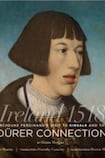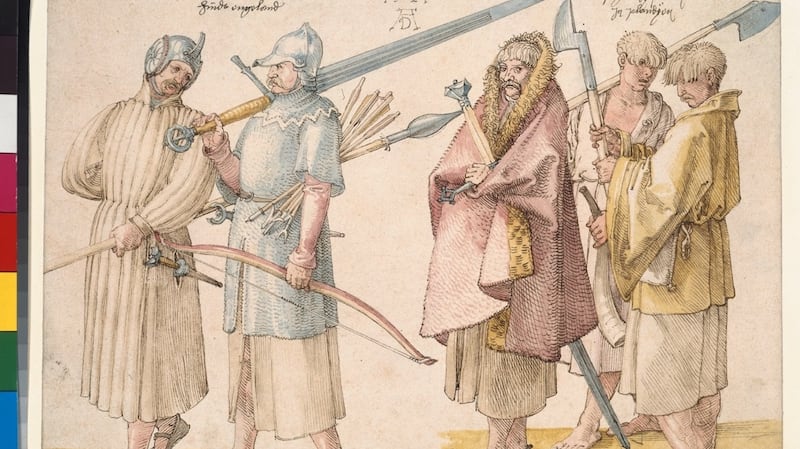
Kinsale, in 1518, was a walled town inhabited by perhaps 1,500 people whose everyday language was Irish and who prospered by importing wine and salt, principally from Spain, in exchange for the commodities of the countryside and the ocean.
The tranquillity of the residents was disrupted on June 6th by the dramatic arrival of five large three-masted vessels carrying about 400 people, including nobles, servants, entertainers, soldiers, and mariners together with horses to meet their requirements once they reached their destination. Those aboard sent a delegation ashore to explain that they had been blown off course when sailing from Santander to Flanders, and were in need of fresh water and food for which they could pay. The town elders would soon learn that they had become hosts to the 15-year-old Archduke Ferdinand, son of Philip the Fair of Burgundy and his wife, Joanna the Mad, and grandson to King Ferdinand and Queen Isabella of Spain.
The archduke was being brought from Spain, where he had been fostered in a noble household, to Flanders, where he was required to deputise for his older brother Charles as duke of Burgundy because Charles had just been brought from Flanders by this same entourage to be crowned King of Spain. Charles would also be elected holy Roman emperor in 1519, and Archduke Ferdinand was destined to continue deputising for his older brother in various capacities until 1558, when he succeeded him as emperor after Charles had retired to a monastery.

Thus the burghers of Kinsale had as their guest one of Europe’s most illustrious princes, who also happened to be nephew of their own queen Catherine of Aragon, wife of King Henry VIII. One Laurent Vital, a personal attendant to the archduke, undertook “to recall or put in memory what happened on the voyage”, and he solicited assistance for the Kinsale episode from an “honest old man” of the town who could converse in French, having spent years in Normandy.
Storm-tossed voyage
The section of Vital’s narrative describing the journey of Charles from Flanders to Valladolid, where he was crowned king of Spain, is frequently cited. Hiram Morgan, however, is the first to appreciate the merit of Vital’s report on the storm-tossed return voyage to Flanders with its fascinating account of the four-day sojourn in Kinsale. This very attractive edition of the text includes a translation from the original 16th-century French prepared by Dorothy Convery; a critical appraisal by Morgan; several depictions of people, places and objects drawn from contemporary sources, and a portfolio of sketches by Hector McDonnell that bring Vital’s narrative to life. The result is an unusually attractive and interesting compilation.
Vital was a keen observer and an excellent narrator, and the only interpretative difficulty is in determining where his reportage was influenced by what he had previously heard or read of Ireland, or by the prejudices of the old man who guided him through Kinsale.
The fact that Vital enquired specifically about St Patrick’s Purgatory suggests he had preconceived ideas about this famed penitential place, and he must have been disappointed when the only extra information he could glean came from the sister of the “old man” who had made her pilgrimage there when she was just 15 and whose recollection was mediated to Vital through her brother.
What Vital had to say of the “savages” who he believed to be “masters” of the surrounding countryside, probably reflected the prejudices of his guide rather than any extramural sightings by Vital.
The eyewitness impressions of Vital are therefore more interesting. These included the enactment of what was probably a forced trial marriage at the door of a church; High Mass being “sung counterpoint which is neither descant nor plainsong”; the entertainment provided by the town to a delegation from the ships; the reciprocal hospitality offered by the archduke on the beach where he received his guests under a canopy made of cloth of gold; and the harp playing and singing of the Passion of Christ by a “savage” who had been sent by the earl of Desmond to entertain the archduke as his ship was about to depart. Verbal communication proved possible through the use, in different situations, of English, French and Latin.
Vital was especially interested in the dress (or undress) of the people he saw in Kinsale and in the weapons he witnessed them bearing and using. Generally, he found the men and women “so strangely and singularly costumed” that he considered it a subject of laughter. However, while he contrasted their attire with that worn by people from other remote rural regions of Europe, he still commented positively on their food and hospitality and witnessed “only goodness and honour” everywhere in Kinsale.
Morgan has been rightly impressed by Vital’s pen pictures of the dress and weaponry of the Irish and believes “the first Renaissance image” of Irish people executed in 1521 by Albrecht Dürer “almost certainly” was inspired by Vital’s verbal descriptions from Kinsale. Morgan sustains this belief not only by citing the circumstantial evidence that Vital and Dürer were in the same place at the same time, but, more convincingly, by relating the clothes and weapons depicted in the Dürer drawing to those detailed in the Vital narrative.
For me, the most convincing evidence is that neither the drawing nor the narrative depicted the gallowglass axe which was the most distinctive weapon employed by Irish soldiers of that era and which would not have escaped Dürer’s attention if he had been “drawing from life” actual Irish soldiers in Antwerp. Morgan has done well in bringing this forgotten account to a wider audience, and in persuading us that Dürer made good what Vital considered a shortfall when, in describing Irish attire, he remarked he had “never seen anything like this before even in a painting”.
Nicholas Canny is emeritus professor of history at NUI Galway. He is completing a book to be called Early Modern Ireland in Contexts












